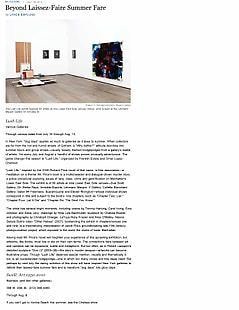
Beyond Laissez-Faire Summer Fare
Lance Esplund
Lush Life
Various Galleries
Through various dates from July 30 through Aug. 13.
In New York, "dog days" applies as much to galleries as it does to summer. When collectors are far from the hot and humid streets of Gotham, a "Why bother?" attitude devolves into summer hours and group shows—usually loosely themed hodgepodges from a gallery's stable of artists. Yet every July and August a handful of shows proves unusually adventurous. The game-changer this season is "Lush Life," organized by Franklin Evans and Omar Lopez-Chahoud.
"Lush Life," inspired by the 2008 Richard Price novel of that name, is free association—a meditation on a theme. Mr. Price's book is a multicharacter and dialogue-driven murder story, a police procedural exploring issues of race, class, crime and gentrification on Manhattan's Lower East Side. The exhibit is of 60 artists at nine Lower East Side venues—Sue Scott Gallery, On Stellar Rays, Invisible-Exports, Lehmann Maupin, Y Gallery, Collette Blanchard Gallery, Salon 94 Freemans, Scaramouche and Eleven Rivington—whose individual shows correspond in title and subject to the book's nine chapters, such as "Chapter Two: Liar," "Chapter Four: Let It Die" and "Chapter Six: The Devil You Know."
The show has several bright moments, including videos by Tommy Hartung, Carol Irving, Ezra Johnson and Dana Levy; drawings by Nina Lola Bachhuber; sculpture by Chakaia Booker; and photographs by Christoph Draeger, LaToya Ruby Frazier and Alice O'Malley. Nanna Debois Buhl's video "Other Halves" (2007), bookending the exhibit in chapters/venues one and nine, is a mesmerizing interpretation of Jacob Riis's groundbreaking late-19th-century photojournalism project, which exposed to the world the slums of lower Manhattan.
Having read Mr. Price's novel will heighten your experience of this sprawling exhibition; but artworks, like books, must live or die on their own terms. The connections here between art and narrative can be expansive, subtle and metaphoric. But too often, as in Robert Lazzarini's distorted sculpture "Gun (i)" (2005-08)—the story's murder weapon—artworks can become illustrative props. Though "Lush Life" deserves special mention, visually and thematically it, too, is an overextended hodgepodge—one in which too many voices and trite ideas clash. But perhaps by next July the daring ambition of this show will have inspired New York galleries to rethink their laissez-faire summer fare and to transform "dog days" into glory days.
Swell: Art 1950-2010
Nyehaus (and two other galleries)
358 W. 20th St., (212) 366-4493
Through Aug. 6
If you can't get to Venice Beach this summer, see the Chelsea show "Swell: Art 1950-2010" for a broad and long view of Pacific Coast culture. More laid-back than "Lush Life," yet equally uneven, "Swell," at Nyehaus, Friedrich Petzel and Metro Pictures, moves beyond the easy pleasures of ocean surf, sand, salt air and bikinis.
Its nearly 75 artists represent newcomers along with the full cast of beach bums who brought us the West Coast aesthetic—the Southern California Minimalism that combined lowriders, plastics, neon lights and sunset colors. At the show's core are surfing and the surfboard—in actuality and shape—which gives these three galleries the feel of a prop room on the set of an Annette Funicello movie. But antiwar art from the 1960s, along with a hand-painted bomb by Steve Olson, "USA Baby" (2010), remind us how much the shapes of missiles, surfboards and male and female genitalia have in common. The small sculpture "Mimi" (2001), by Los Angeles native Ken Price (b. 1935), is a conflation of sequined glove and rearing horse; of udder, phallus and cresting wave. Like this show's subject, "Mimi" is menacing and playful; edgy and erotic. It is perfectly placed in an exhibition that underscores the fact that no matter where you live, life is no picnic on the beach.
Jane Culp: Wilderness Work 2010
Bowery Gallery
530 W. 25th St., (646) 230-6655
Through July 31
The rugged mountains, desert and wild lands of Southern California are mirrored in Jane Culp's paint handling, and even in her approach to paper and canvas. "When working outside in the desert, with its overpowering winds and relentless sun," the landscape painter writes, "I strap my easel to my legs.... When I work a watercolor, it is [held to] the ground with either my knees or my feet."
Yet despite her struggle with the elements, Ms. Culp arrives in these expressive oils, charcoals and watercolors at a place of structural clarity and composure—while making palpable the rush she feels interacting with nature. Her pictures' restless skies and stepped, sharply carved mountain peaks retain the vastness, monumentality and naturalism of their subjects. Yet ultimately she is painting not the landscape but the thrill of engagement. In "Eagle's Nest Peak, Anza" (2008), Ms. Culp transforms desert mauves and pinks into rising swells resembling human flesh. In "Snowy Peaks above Tioga Pass, Yosemite" (2009), she turns mountain and sky into ocean storm. We sense in these landscapes not a painter stationed before her subject but a traveler lashed to the mast amid high seas.
—Mr. Esplund writes about art for the Journal.
